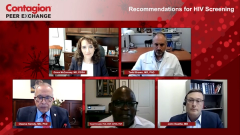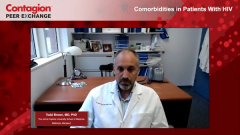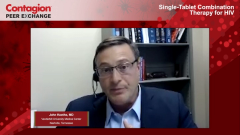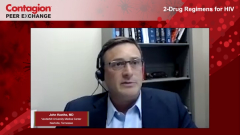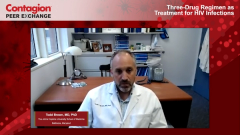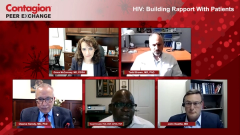
Relationship Between HIV & Obesity and Diabetes
The relationship between diabetes and obesity and therapies commonly used to manage patients with HIV infections.
Episodes in this series

Grace McComsey, MD, FIDSA: Dr. Hamdy, Osama, I want to bring you in. I know you don’t deal with HIV [human immunodeficiency virus] treatment per se, but you’re a diabetes and obesity expert, two complications that we see quite a bit in our patients. How much do these complications affect quality of life, even without HIV? Maybe you can talk about your experience.
Osama Hamdy, MD, PhD: Grace, first I would like to thank you very much for inviting Todd and myself. I believe the discussion with endocrinologists is very important when HIV is addressed. And I would like just to say that when we see any patients with HIV, we must think of diabetes. This is very important. People with HIV are 4 to 5 times in general at risk to develop type 2 diabetes. Not only that, people are even believed now that part of the diabetes epidemic is also related to HIV. For example, if you look to where we are now across the globe, around 426 million with diabetes, expected to go in 2045 to around 629 million. Now, if you consider just inactivity and bad eating habits and all that stuff as risk factors, we have now to think seriously there are some other risk factors like infection and HIV. If you have 35 million with HIV globally, maybe this could be included as well. I would like to bring to the mind of everyone that the virus itself and the treatment both are related. From a pathophysiological point of view, I would just to explain this and then I will go back to what you’re asking about. The virus itself interferes with what’s called cellular retinoic binding protein, which leads to inhibition of BPR gamma that lead to many other problems, like insulin resistance, like adipose tissue inflammation, and also to increase free fatty acids into circulation. All of this leads to a certain degree of inflammation that can provoke many other metabolic problems. On the top of them, diabetes, type 2 diabetes, and atherosclerosis.
Our research, many years ago, showed that once you introduce inflammation in the adipose tissue and you have provocation from TNF alpha [tumour necrosis factor alpha] and IL-6 [interleukin 6] and MCP-1 [monocyte chemoattractant protein-1] and all those provocative inflammatory cytokines, you will see all kinds of metabolic problems, including insulin resistance and endothelial dysfunction and then atherosclerosis. From a medication point of view also, there is a problem, and especially with the older medications. For example, if you look to people who started treatment with the old protease inhibitors between 1997 and 2004, those people have 50 times higher risk to develop type 2 diabetes. And we’re still seeing those people now because, as John mentioned, they are living for longer, longer duration. And many of the older medications also significantly increase the risk, even if people used it for a short period of time. That’s why I would like to bring to the attention that diabetes is something that you should think of all the time when you have anyone with HIV. Now, the burden of the disease and the burden of diabetes, which require 24/7 attention, because this is again another big problem and big disease, require testing, require modification of lifestyle, require medications, this is a major dilemma. And then when people start to gain weight as well and then have all the problems that comes in the baggage of weight, like obstructive sleep apnea, arthritis, and of course worsening of diabetes and cardiovascular disease and pulmonary issues and so on, it became like a big dilemma. The burden is significantly high, significantly high on those people when they have the combined infection.
Grace McComsey, MD, FIDSA: Perfect, thank you for that discussion.
Transcript Edited for Clarity
Newsletter
Stay ahead of emerging infectious disease threats with expert insights and breaking research. Subscribe now to get updates delivered straight to your inbox.

